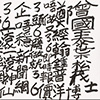Catalogue Note:
AN ETERNAL CONTINUANCE
TSANG TSOU CHOI
“Tsang Tsou-choi’s sense of the topography of power was not a static one, but displayed awareness of the shifts that occurred with the return of Hong Kong to Chinese rule. At first in artistic contexts and then in a wider way, Tsang became one of the most established symbols of Hong Kong cultural identify.” – David Clarke.
An Eternal Continuance made references to a phrase of an economic phenomenon that could be widely resonated with by reference to prevalent domain names such as 36.com within the wider context of an international dotcom boom and bust. A time period when the IPOs of internet companies emerged with ferocity and frequency, sweeping the region in euphoria. Executed in 2000, the present lot captivates a period in time where the immediate knowledge at the click of a button is celebrated, more importantly it incorporates visual elements that can be interpreted as the summation of an era while simultaneously constituting an idiosyncratic symbol for Hong Kong culture.
Tsang began his life-long career in the 1960s and had committedly written his genealogy and idiosyncratic interpretations of history across Hong Kong. The King of Kowloon derived an individual style and has made his art an extraordinary engaging language at a time when there was no such category to legitimize it. More specifically, his works echo monumental public calligraphy in traditional China and come across as a public form of visual language of power. The characters on the present lot are deftly arranged whereby large and small characters alternate to achieve a style that excels in its plainness and simplicity, but yet reflects cohesion in the overall composition. The structure of the characters in his creations is coherent and well balanced, but never rigid and inflexible. In essence, his bold style is not restricted by formal rules and regulations. Instead, it deviates according to space and time, the texture of the surface to be written on, and his moods. In retrospect, Tsang’s eccentric style of writing inspired many subsequent artistic productions such as the superimposition of his calligraphy on an ad. By the 1990s he started to gain recognition in the art world and was included in a series of integral exhibitions.
In essence, the characters on the present lot illuminate ideas that can be easily incorporated into a constellation of very real personal and sociopolitical concerns during the millennium, a period marked with economic prosperity and anxieties that continue to resonate within and far beyond Hong Kong. The art historian David Clarke derived a greater sentimental value from the works of the late King, as Tsang’s works were often deemed to be anti-colonial under British rule but had transferred into a quintessential local phenomenon that affirm a distinctive cultural identity after Hong Kong’s retrocession to mainland China. Tsang calligraphy is reminiscence of a preordained destiny and the survival of a set of ideologies from the past, achieved by a figure standing on the margin of society and popular culture.


